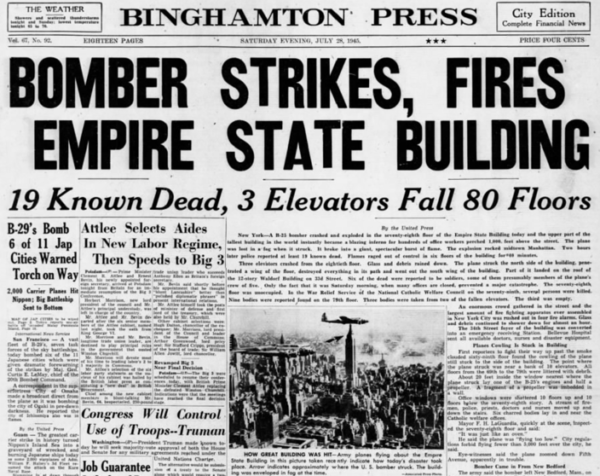On This Date in 1945: Bomber Strikes Empire State Building
Headlines on the last weekend in July 1945 focused on the planning for the dreaded invasion of Japan by Allied forces. The war in Europe was over. In the Pacific, the Imperial Navy had been virtually destroyed and Allied bombers were raking Tokyo mercilessly. But war planners feared that a hard-fought and costly invasion was going to be required to bring the global war to a close.
Weather maps on the morning of July 28, 1945, showed a long stationary front that snaked across the Ohio Valley and into the Mid-Atlantic states. AT 2:30 a.m. Eastern War Time, the front was analyzed by forecasters between Washington D.C. and Richmond. The boundary separated cooler, dry air over the Northeast from the tropical air over the South. As streets in the Big Apple sprang to life early on that Saturday morning, the huge buildings of Manhattan were shrouded in fog and low clouds.
At the helm of a B-25 Billy Mitchell bomber, Lt. Col. William Franklin Smith, Jr., was flying a routine personnel transport mission from Boston to LaGuardia Airport in New York City. As he attempted to land, the visibility at the field was zero. He decided to divert to Newark. As he flew his plane over the city, he decided to attempt to get below the cloud deck to look for landmarks.
He found himself in the canyons between the skyscrapers of Manhattan. At 9:40 a.m., the plane crashed into the north side of the Empire State Building, then the world’s tallest building. The bomber was lodged in a gaping hole between the 78th and 80th floors. Debris and gasoline rained on the city streets below. New Yorkers believed their city was under attack.
The fire was brought under control, but when all the dust settled, 14 people had died. The 3 people on the plane perished as well as 11 in the building. An injured elevator operator survived a 75 story elevator fall when the cab plunged after its cable, weakened in the crash, fell all the way to the bottom of the building.
Category: ALL POSTS, Met 101/Weather History
















